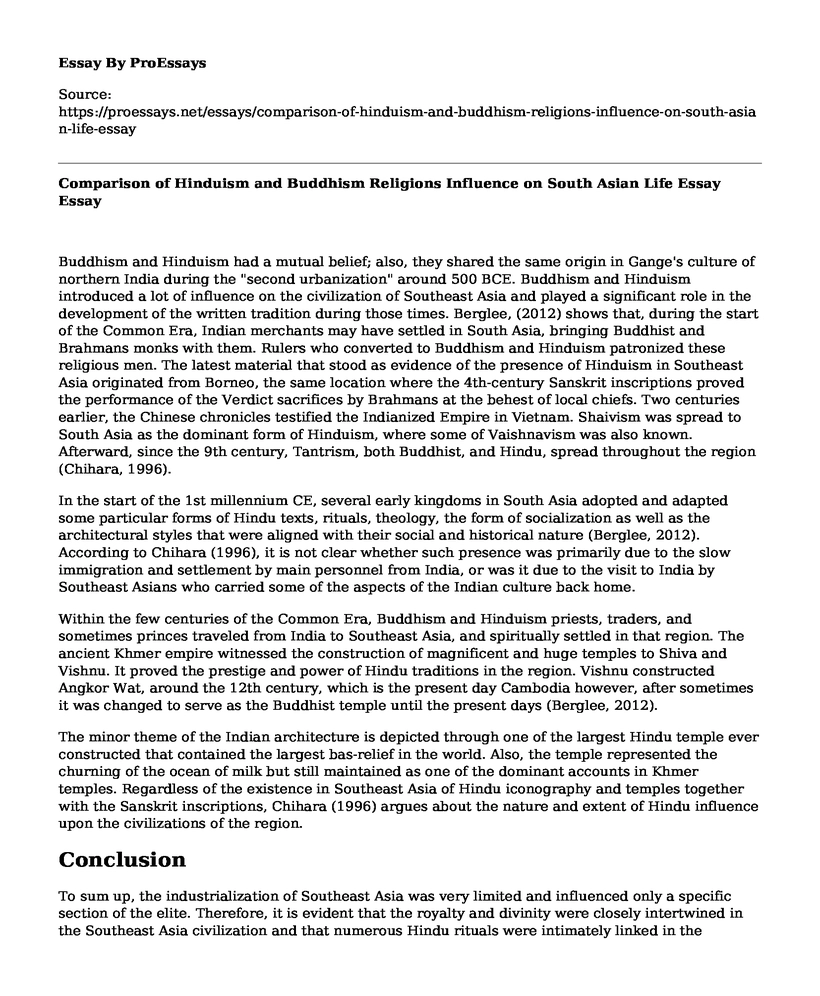Buddhism and Hinduism had a mutual belief; also, they shared the same origin in Gange's culture of northern India during the "second urbanization" around 500 BCE. Buddhism and Hinduism introduced a lot of influence on the civilization of Southeast Asia and played a significant role in the development of the written tradition during those times. Berglee, (2012) shows that, during the start of the Common Era, Indian merchants may have settled in South Asia, bringing Buddhist and Brahmans monks with them. Rulers who converted to Buddhism and Hinduism patronized these religious men. The latest material that stood as evidence of the presence of Hinduism in Southeast Asia originated from Borneo, the same location where the 4th-century Sanskrit inscriptions proved the performance of the Verdict sacrifices by Brahmans at the behest of local chiefs. Two centuries earlier, the Chinese chronicles testified the Indianized Empire in Vietnam. Shaivism was spread to South Asia as the dominant form of Hinduism, where some of Vaishnavism was also known. Afterward, since the 9th century, Tantrism, both Buddhist, and Hindu, spread throughout the region (Chihara, 1996).
In the start of the 1st millennium CE, several early kingdoms in South Asia adopted and adapted some particular forms of Hindu texts, rituals, theology, the form of socialization as well as the architectural styles that were aligned with their social and historical nature (Berglee, 2012). According to Chihara (1996), it is not clear whether such presence was primarily due to the slow immigration and settlement by main personnel from India, or was it due to the visit to India by Southeast Asians who carried some of the aspects of the Indian culture back home.
Within the few centuries of the Common Era, Buddhism and Hinduism priests, traders, and sometimes princes traveled from India to Southeast Asia, and spiritually settled in that region. The ancient Khmer empire witnessed the construction of magnificent and huge temples to Shiva and Vishnu. It proved the prestige and power of Hindu traditions in the region. Vishnu constructed Angkor Wat, around the 12th century, which is the present day Cambodia however, after sometimes it was changed to serve as the Buddhist temple until the present days (Berglee, 2012).
The minor theme of the Indian architecture is depicted through one of the largest Hindu temple ever constructed that contained the largest bas-relief in the world. Also, the temple represented the churning of the ocean of milk but still maintained as one of the dominant accounts in Khmer temples. Regardless of the existence in Southeast Asia of Hindu iconography and temples together with the Sanskrit inscriptions, Chihara (1996) argues about the nature and extent of Hindu influence upon the civilizations of the region.
Conclusion
To sum up, the industrialization of Southeast Asia was very limited and influenced only a specific section of the elite. Therefore, it is evident that the royalty and divinity were closely intertwined in the Southeast Asia civilization and that numerous Hindu rituals were intimately linked in the Southeast Asia civilization and several of the Hindu rituals were practiced to valorize the powers of the monarch. The civilization experienced in Southeast Asia introduced forms of Buddhism and Hinduism that included different local features together with other aspects that depicted the local cultures, though the frameworks of their religious culture, at least in the upper classes, was widely Indians. In Indonesia, the Bali people still respect the form of Hinduism that they had earlier adopted. The Manu-Smriti versions were taken to Southeast Asia then translated and adapted to indigenous culture until the original content got eroded.
References
Berglee, R. (2012). World Regional Geography: People, Places, and Globalization. The Saylor Foundation. Retrieved from https://saylordotorg.github.io/text_world-regional-geography-people-places-and-globalization/s12-05-religions-of-india-and-south-a.html
Chihara, D. (1996). Hindu-Buddhist Architecture in Southeast Asia (Vol. 19). Brill.
Cite this page
Comparison of Hinduism and Buddhism Religions Influence on South Asian Life Essay. (2022, Nov 20). Retrieved from https://proessays.net/essays/comparison-of-hinduism-and-buddhism-religions-influence-on-south-asian-life-essay
If you are the original author of this essay and no longer wish to have it published on the ProEssays website, please click below to request its removal:
- The Muslim Community in History According to Esposito
- Essay Example: Social Factors of Canada Fishing
- Business Laws and Regulations in Canada Essay
- Faith Integration Paper: Wealth Accumulation
- Essay Example on Plenary Powers in the US Constitution
- Crime Statistics of 5 Major Cities - Report Example
- Paper Example on Social Demography: How to Reduce the Divorce Rate in the United States







